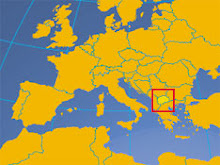Marathon Over the Mountain
"I can't wait to go to bed tonight," said Conor.
This blog chronicles Dan and Jillian Kearney's ongoing adventures as Peace Corps volunteers in the Republic of Macedonia. The contents of this Web site are theirs personally and do not reflect any position of the U.S. Government or the Peace Corps.
"I can't wait to go to bed tonight," said Conor.
Posted by
Dan and Jillian
at
9:34 AM
0
comments
![]()
Labels: hiking, Macedonia, Peace Corps
Like we mentioned last year around this time, prom is a big deal in our little town. Sure, the students have been talking about it for what seems like months--but that's normal, I think. What's surprising is the way the prom becomes a public spectacle. Like the circus, it's got something for everyone who lines up outside the motel, four or five deep, to watch the seniors arrive. Girls in new, elegant dresses? Got it. Girls in new, ugly dresses? Got it. Boys in shiny suits and sports shoes? Got that, too. Cars spinning out in the dirt parking lot, coating grandmothers in dust? Oh yeah, there's lots of that. So the flashes snap away as the seniors enter along the red carpet. Jillian and I popped in for a bit to take a few pictures and then left before we got roped into dancing the oro.
Posted by
Dan and Jillian
at
9:17 AM
1 comments
![]()
Labels: Macedonia, Peace Corps, prom
As holiday travel goes, even for cheapskate backpackers like us, this was a new one: we'd hitched a ride across Transylvania (central Romania) with a bus of second graders on a school field trip. No, there's no punchline; the driver was playing something like European "Jock Jams" over the bus speakers and a group of rowdy little boys bounced around behind us, singing along as if they were in fact seated in a soccer stadium and not row 17 of a chartered bus. A few parent-chaperones chatted in front of us and David, our friend and a teacher at this particular school, strolled the aisle taking pictures of drowsy kids. Nothing unusual here.
Posted by
Dan and Jillian
at
7:37 AM
1 comments
![]()
Labels: Budapest, Hungary, Macedonia, Peace Corps, Romania, Transylvania
We're in the full grip of spring and all the things that come with it: unpredictable weather, allergies, suddenly overgrown lawns, the greening of the hillsides, the swelling of the river and, finally, an opportunity to do some hiking. There's no shortage of hiking destinations in these parts, but there is a lack of what we Americans would term "hiking trails." This frustrated us during our first spring and summer. From the municipality we obtained a rather well-produced hiking map, made in conjunction with a town in Bulgaria as part of a cross-border project. Problem is, the map shows only two "eco-trails" (as they are called) in our greater area. And we've hiked them both.
Turns out we were going about this in the wrong way. It's like the last scene in Back the Future. Marty says, "Whoa, Doc, there's not enough road to get up to 88 mph." And wild-haired Doc Brown smiles and replies, "Roads? Where we're going we don't need any roads." And the Delorean lifts up from the ground and blasts off into the sequel.
Trails? Where we're going we don't need any hiking trails. We just pick a village and start walking.
There are three distinct settlement types in Macedonia: cities, towns, and villages. The cities, like Skopje, Tetovo or Bitola, have a distinct Western bend and include most things you'd associate with America or western Europe: expensive shopping, fast-food, movie theaters, malls, albeit with a blocky concrete/communist twist. The towns? Well, they're just lesser versions of the cities; they hold a certain amount of rustic-ness but also offer enough Western amenities to make you feel comfortable.
When you picture Peace Corps Volunteers serving around the world you probably don't envision them in places like Macedonian towns and you most certainly don't think of cities. No, if you close your eyes and conjure a PCV hard at work, what most closely resembles that image in your head is a Macedonian village. Rural and antiquated, villages are scattered everywhere across Macedonia.
In our municipality there are around 33 villages tucked into the hillsides, ravines and mountain slopes. It's quite common to hear someone in town refer to "my village" or "my family's village." Many families trace their roots back to these small settlements and have relatives still living there. So these villages become destinations in the summer, when their altitude provides some relief from the heat.
Getting to these villages--and getting out of them--is not always easy. Once you leave town, the roads quickly lose their pavement and become rough dirt trails. They're also quite narrow and every half kilometer or so there's a small turnout to assist any drivers that may meet head-on coming up and down the mountain. During the winter one particularly rural village found itself snowed in and Red Cross helicopters were called in to deliver the necessary supplies.
Posted by
Dan and Jillian
at
1:43 AM
0
comments
![]()
Labels: hiking, Macedonia, Peace Corps
This time I was prepared. Like a Discovery Channel photographer lying in wait in the bush for weeks, I'd been studying the habits of this particular herd of children and knew exactly what to expect. No sooner had I given the routine flick of my hand and said "Готово!" (finished) then the kids charged, engulfing us in a monsoon of hugs. This is no exaggeration--forty children jumped up from their seats and bum rushed us. As Jillian said after, "I had to widen my stance to keep from falling over."
Posted by
Dan and Jillian
at
2:24 AM
1 comments
![]()
Labels: English classes, Macedonia, Peace Corps, Roma

